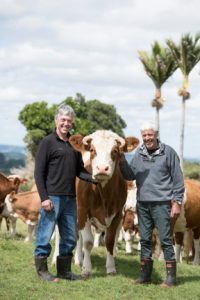The Thompson family have switched their cattle operations from steep Wanganui hills to easier land with profitable results. Russell Priest reports.
A win-win agreement between father and son, Brian and Kerry Thompson and Horizons Regional Council has seen the Thompsons’ long-established Simmental herd move from extremely steep terrain to gently rolling pastures next door. Since then it hasn’t looked back.
In 2013 the Thompson partnership completed a Whole Farm Plan with Horizons as part of the council’s Sustainable Land Use Initiative. Implementation of this plan has resulted in about 500 hectares of steep land planted in forestry or retired in a partnership deal with the council. Capital released from this arrangement has been invested by the Thompsons in 100ha of easy-contoured neighbouring land leaving them with an effective farm area of 400ha down from 800ha previously. They also lease 20ha from a neighbour.

“We are now running the same number of ewes and 30% fewer cattle on half the area and it is much more profitable,” Kerry says.
Established in the 1980s in response to strong market demand for Simmental cattle, the Thompsons’ pure-bred herd now numbers about 70 cows down from the 100 they used to have when they were run on the hills.
“We used to winter the cows on the hills then bring them on to the flats for calving and to maintain pasture quality over the spring/summer period,” Brian says.
“Now we’ve got limited hill country we have to feed out to them for three months over the winter.”
Brian ran Angus cows before switching to Simmentals and is adamant the latter performed as well as the former on the hills. Since moving to the easier country however herd performance has moved to a higher level.
‘Nowadays we lose very few cows but on the hills we used to lose a significant number as a result of them losing their footing.’
“Nowadays we lose very few cows but on the hills we used to lose a significant number as a result of them losing their footing.”
Consequently, calving percentage used to hover between 75% and 80% for both breeds but now it’s in the early 90s.
All weaners used to be wintered and the steers and surplus heifers sold in January at 13-14 months. With the loss of the hills fewer cattle are now wintered and steers are sold as weaners off their mothers at a relatively young age (calving starts late October).
Heifer calves are wintered together with replacement R2 heifers on saved grass and regrowth Pasja/Raphno brassica drilled in the autumn with an annual ryegrass. Surplus weaner heifers are sold in January at 15 months and weaner steers are sold to a repeat private buyer. Last year at six months and 240kg they returned $900 nett.
Partly because the Thompsons have an aversion to calving females and partly because they don’t have the facilities to cope with difficult calvings they prefer to calve their heifers as three-year-olds.
Kerry openly admits there may be more financially attractive alternatives to breeding cows. However, they do perform an important role in maintaining pasture quality, the benefits of which are difficult to quantify and they enjoy farming them.
Well-known Simmental breeder Tony Thompson, Brian’s brother, supplies their bulls.
Three generations
Kerry and his wife Julie are the third generation of the Thompson family to farm in the area. They have two daughters; Danielle (18) and Madeleine (16).
Kerry’s father Brian and his wife Olive live on the original 51ha block, Tirohanga, settled by his parents (John and Molly) in 1934. The previous owners used it to supply themselves with wild pork. Brian was one of seven children (three boys and four girls) and has lived in the area all his 83 years. His parents milked cows (up to 10), made and sold butter within the local community, fattened Ryeland Romney cross wethers and supplemented their income by shearing and droving.
Over the years the area farmed by the Thompson clan waxed and waned but when Kerry returned from Auckland in 2002 after working for Telecom the farm totalled 1490ha of which only 800ha were effective (the rest was in native bush).
- For more, see the July edition of Country-Wide




